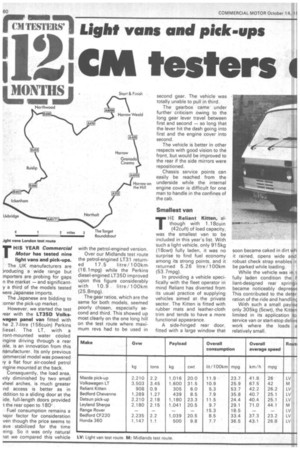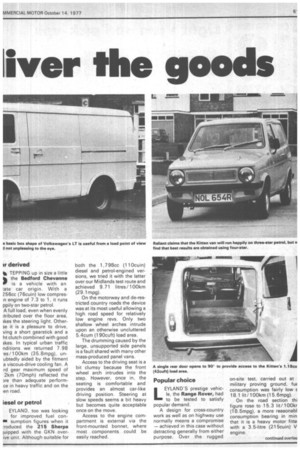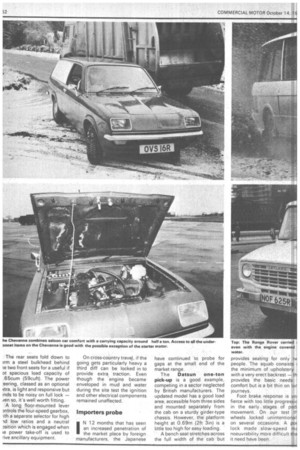I I CM testers a
Page 62

Page 63

Page 64

Page 65

Page 67

If you've noticed an error in this article please click here to report it so we can fix it.
liver the goods
rHIS YEAR Commercial Motor has tested nine light vans and pick-ups. The UK manufacturers are )roducing a wide range but mporters are probing for gaps n the market and significanty a third of the models tested 'were Japanese imports.
The Japanese are bidding to :orner the pick-up market.
However, we started the test rear with the LT350 Volkswagen panel van fitted with he 2.7-litre (156cuin) Perkins liesel. The LT, with a ront-mounted water cooled !ngine driving through a rear ixle, is an innovation from this nanufacturer. Its only previous :ommercial model was powered ly a flat four air-cooled petrol !ngine mounted at the back.
Consequently, the load area, ally diminished by two small wheel arches, is much greater nd access is better as in ddition to a sliding door at the ide, full-length doors provided t the rear open to 180' .
Fuel consumption remains a iajor factor for consideration ven though the price seems to lave stabilized for the time ,eing. So it was only natural let we compared this vehicle
with the petrol-engined version. Over our Midlands test route the petrol-engined LT31 return ed 17.5 litre/ 100km• (16.1mpg) while the Perkins diesel-engined LT350 improved upon this figure considerably with 10.9 litre/ 100km (25.8mpg).
The gear ratios, which are the same for both models, seemed poorly chosen, especially second and third. This showed up most clearly on the one long hill on the test route where maximum revs had to be used in second gear. The vehicle was totally unable to pull in third.
The gearbox came under further criticism owing to the long gear lever travel between first and second so long that the lever hit the dash going into first and the engine cover into second.
The vehicle is better in other respects with good vision to the front, but would be improved to the rear if the side mirrors were repositioned.
Chassis service points can easily be reached from the underside while the internal engine cover is difficult for one man to handle in the confines of the cab.
Smallest van THE Reliant Kitten, although with 1.18cuin (42cuft) of load capacity, was the smallest van to be included in this year's list. With such a light vehicle, only 915kg (18cwt) fully laden, it was no surprise to find fuel economy among its strong points, and it returned 5.26 litre/100km (53.7mpg).
In providing a vehicle specifically with the fleet operator in mind Reliant has diverted from its usual practice of supplying vehicles aimed at • the private sector. The Kitten is fitted with rubber mats and leather-cloth trim and tends to have a more functional appearance.
A side-hinged rear door, fitted with a large window that
soon became caked in dirt wh it rained, opens wide and robust check strap enables it be parked while loading.
While the vehicle was in t fully laden condition the F liant-designed rear springil became noticeably depresse This contributed to the deter ration of the ride and handlinc, With such a small payloa only 305kg (5cwt), the Kitten limited in its application to service van or start-stop delive work where the loads a relatively small.
1r derived ▪ TEPPING up in size a little 11, • the Bedford Cheyenne
is a vehicle with an Late car origin. With a 256cc (76cuin) low compresin engine of 7.3 to 1, it runs ppily on two-star petrol.
A full load, even when evenly tributed over the floor area', 3kes the steering light. Otherse it is a pleasure to drive, ving a short gearstick and a ht clutch combined with good 3kes. In typical urban traffic nditions we returned 7.98 -es / 100km (35.8mpg), unubtedly aided by the fitment a viscous-drive cooling fan. A rd gear maximum speed of 2km (70mph) reflected the Dre than adequate performce in heavy traffic and on the ien road.
iesel or petrol
EYLAND, too was looking
for improved fuel consumption figures when it troduced the 215 Sherpa iuipped with the GKN overive unit. Although suitable for both the 1,798cc (110cuin) diesel and petrol-engined versions, we tried it with the latter over our Midlands test route and achieved 9.71 litres / 100km (29.1 mpg).
On the motorway and de-restricted country roads the device was at its most useful allowing a high road speed for relatively low engine revs. Only two shallow wheel arches intrude upon an otherwise uncluttered 5.4cum (190cuft) load area.
The drumming caused by the large, unsupported side panels is a fault shared with many other mass-produced panel vans.
Access to the driving seat is a bit clumsy because the front wheel arch intrudes into the step. However, once in, the seating is comfortable and provides an almost car-like driving position. Steering at slow speeds seems a bit heavy but becomes quite acceptable once on the move.
Access to the engine compartment is external via the front-mounted bonnet, where most components could be easily reached.
Popular choice EYLAND'S prestige vehicle, the Range Rover, had to be tested to satisfy popular demand.
A design for cross-country work as well as on highway use normally means a compromise — achieved in this case without detracting generally from either purpose. Over the rugged
on-site test, carried out at military proving ground, fu( consumption was fairly low E 18.1 lit/100km (15.6mpg).
On the road section thi figure rose to 15.3 lit/ 100kr (18.5mpg), a more reasonabl consumption bearing in min that it is a heavy motor fitte with a 3.5-litre (215cuin) V engine.
The rear seats fold down to )rm a steel bulkhead behind le two front seats for a useful if at spacious load capacity of .65cum (59cuft) The power eering, classed as an optional On cross-country travel, if the going gets particularly heavy a third diff can be locked in to provide extra traction. Even though the engine became enveloped in mud and water during the site test the ignition and other electrical components remained unaffected. Importers probe IN 12 months that has seen an increased penetration of the market place by foreign manufacturers, the Japanese have continued to probe for gaps at the small end of the market range. The Datsun one-ton pick-up is a good example, competing in a sector neglected by British manufacturers. The updated model has a good load area, accessible from three sides and mounted separately from the cab on a sturdy girder-type chassis. However, the platform height at 0.69m (2ft 3in) is a little too high for easy loading. A bench seat stretches across the full width of the cab but provides seating for only un people. The squab consists the minimum of upholstery with a very erect backrest — th provides the basic needs comfort but is a bit thin on lor journeys. Foot brake response is vei fierce with too little progressic in the early stages of ped movement. On our test tEwheels locked unintentional on several occasions. A pp( lock made slow-speed r-nnoeuvrability more difficult tha it need have been. rhe ride is understandably a !e hard with the full one-ton (load on board and the fuel )sumption is about that ex:ted at 11.59 lit/1001cm t.37mpg). orty pick-up HE Mazda pick-up at first glance appears to be very similar to its Japanese npetition. Closer inspection leath the bonnet, however, closes a sporty overhead mshaft engine equipped with cross-flow head. Inside the cab a Sixties-styled flumn-mounted gearchange id dash-mounted umbrellape handbrake allow leg room ir three people to sit in comfort the bench seaat. Even rough the load area is marginly shorter than provided by its )mpetitor, a full one-ton )yload can be accommodated. rid this does not detract from ; lively performance or fuel msumption returns. mallest pick-up ▪ ROM the Honda stable ▪ comes the TN 360, an integral pick-up truck, the nallest-engined commercial hicle on the UK market. In keeping with the rest of the )hicle the cab stands 1.6m (5ft in) from the ground and is only .3m (4ft 3m) wide — so it's -amped. Despite the small igine — 354cc (21 6cuin) — it roved to be less economical tan expected with a full payload of 500kg (9cwt 3qr) over our light van test route where it returned 7.75 litre /100km (36.47mpg). In fairness to the vehicle it must be said that it is intended for short stop-go journeys around town. On long-distance work with the top speed limited to a recommended 50 mph we found it to be under-powered and required a down-change to negotiate even the slightest incline. Maintenance work is best carried out from underneath even though the engine is accessible through a lift-up cover in the load platform. Improved van OWARDS the end of 1976 Bedford introduced the Opel 2.1-litre (128cuin) diesel engine and consequently made it the standard unit for the CF panel van throughout Europe. Its flexibility and smooth running capability helped the 220 to average 8.44 lit/100km (33.4mpg) on our test. Since the petrol-engined version had been tested many small but significant improvements had been added. Draught proofing around the sliding doors have been trimm ed to fit between t e contours t the sliding doors rid the boc more closely; a d extrude section door runn rs enable th doors to run free a d true. Slow manoe vrability good and it can t rn full circ within a 12m idth withoi having to shunt. The cloth-seat ption shoul now be available and IS WE worth considering At the rear the doors can made to fold ba k along th vehicle sides giving clear acce! to the load area of 6.24cui (238cuft) which is restricted • 1.27m (4.2ft) between if rather high wheel arches. The GM diesel should pro) to be economical for the CF, b the vehicle shared a deficient in common wit most oth the omission of ny bulkhei panel and walk-th ough vans fixed or otherwise as a standa fitment behind th driver's sez












































































































































































